Impact of TPP on Canadian Business Economics: An Analysis
VerifiedAdded on 2020/05/16
|25
|4404
|73
Report
AI Summary
This report examines the impact of the Trans-Pacific Partnership (TPP) on Canada's business economics, focusing on the automobile industry. The report begins with an introduction to globalization, liberalization, and trade agreements, particularly the TPP. It then explores the reasons behind Canada's potential non-participation in the TPP, analyzing the agreement's effects on the automobile industry under two scenarios: Canada's participation and non-participation. The analysis considers the impact on Canadian consumers, producers, and non-Canadian stakeholders, along with the implications on demand and supply elasticity. The report also discusses the effects of tariffs, global efficiencies, and provides relevant figures and data to support the analysis. Part 2 includes further analysis of the economic factors. The report concludes by providing a comprehensive overview of the TPP's implications on the Canadian economy, especially the automobile industry.
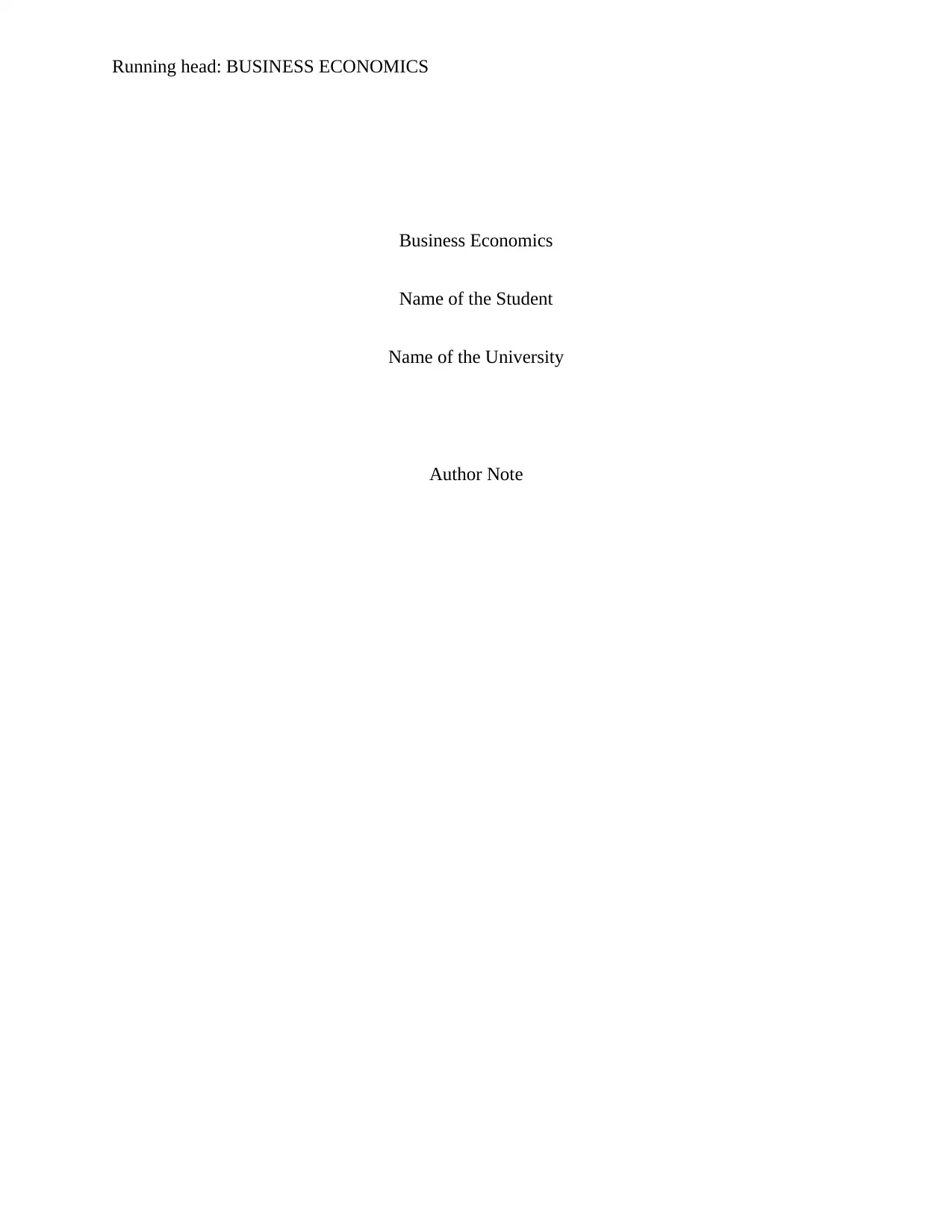
Running head: BUSINESS ECONOMICS
Business Economics
Name of the Student
Name of the University
Author Note
Business Economics
Name of the Student
Name of the University
Author Note
Paraphrase This Document
Need a fresh take? Get an instant paraphrase of this document with our AI Paraphraser
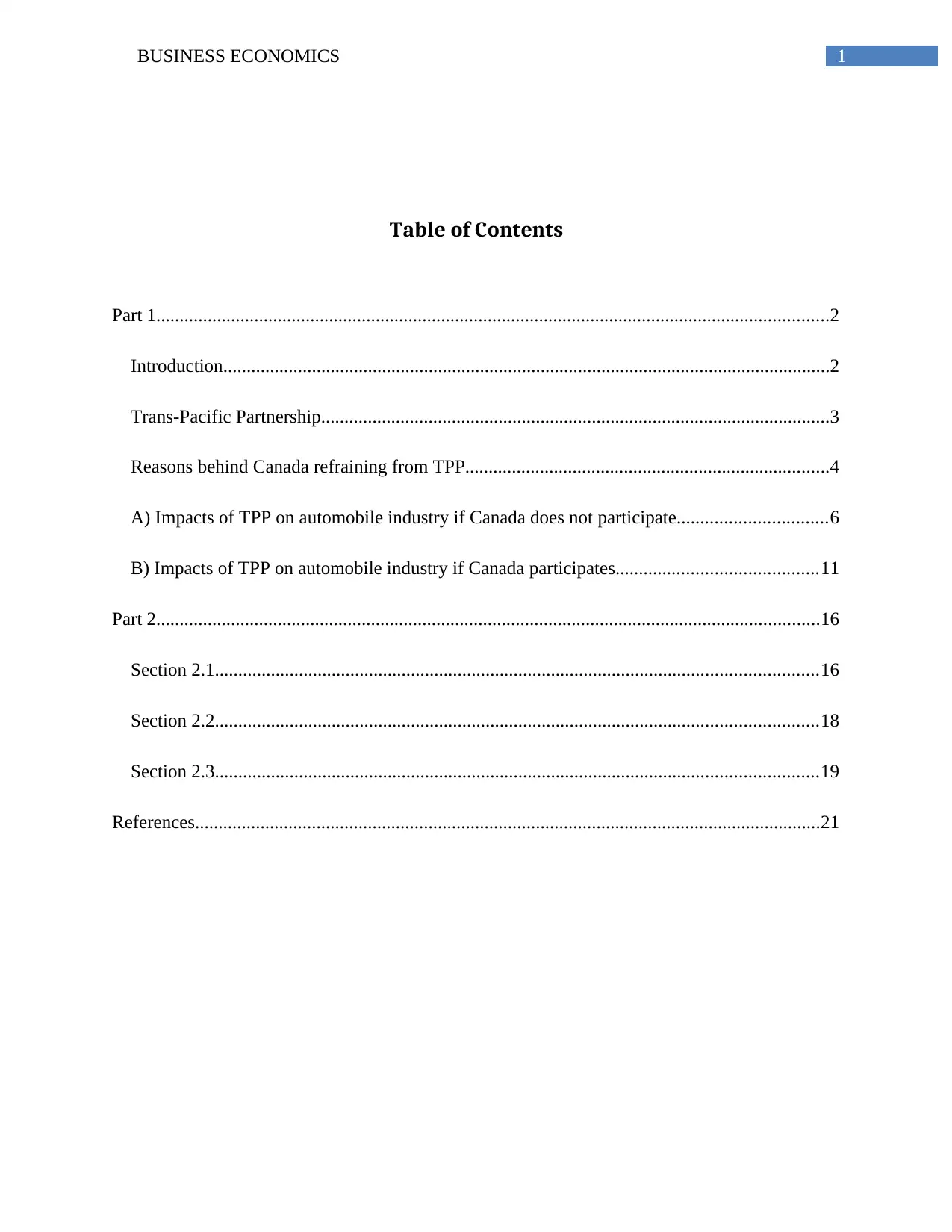
1BUSINESS ECONOMICS
Table of Contents
Part 1................................................................................................................................................2
Introduction..................................................................................................................................2
Trans-Pacific Partnership.............................................................................................................3
Reasons behind Canada refraining from TPP..............................................................................4
A) Impacts of TPP on automobile industry if Canada does not participate................................6
B) Impacts of TPP on automobile industry if Canada participates...........................................11
Part 2..............................................................................................................................................16
Section 2.1.................................................................................................................................16
Section 2.2.................................................................................................................................18
Section 2.3.................................................................................................................................19
References......................................................................................................................................21
Table of Contents
Part 1................................................................................................................................................2
Introduction..................................................................................................................................2
Trans-Pacific Partnership.............................................................................................................3
Reasons behind Canada refraining from TPP..............................................................................4
A) Impacts of TPP on automobile industry if Canada does not participate................................6
B) Impacts of TPP on automobile industry if Canada participates...........................................11
Part 2..............................................................................................................................................16
Section 2.1.................................................................................................................................16
Section 2.2.................................................................................................................................18
Section 2.3.................................................................................................................................19
References......................................................................................................................................21
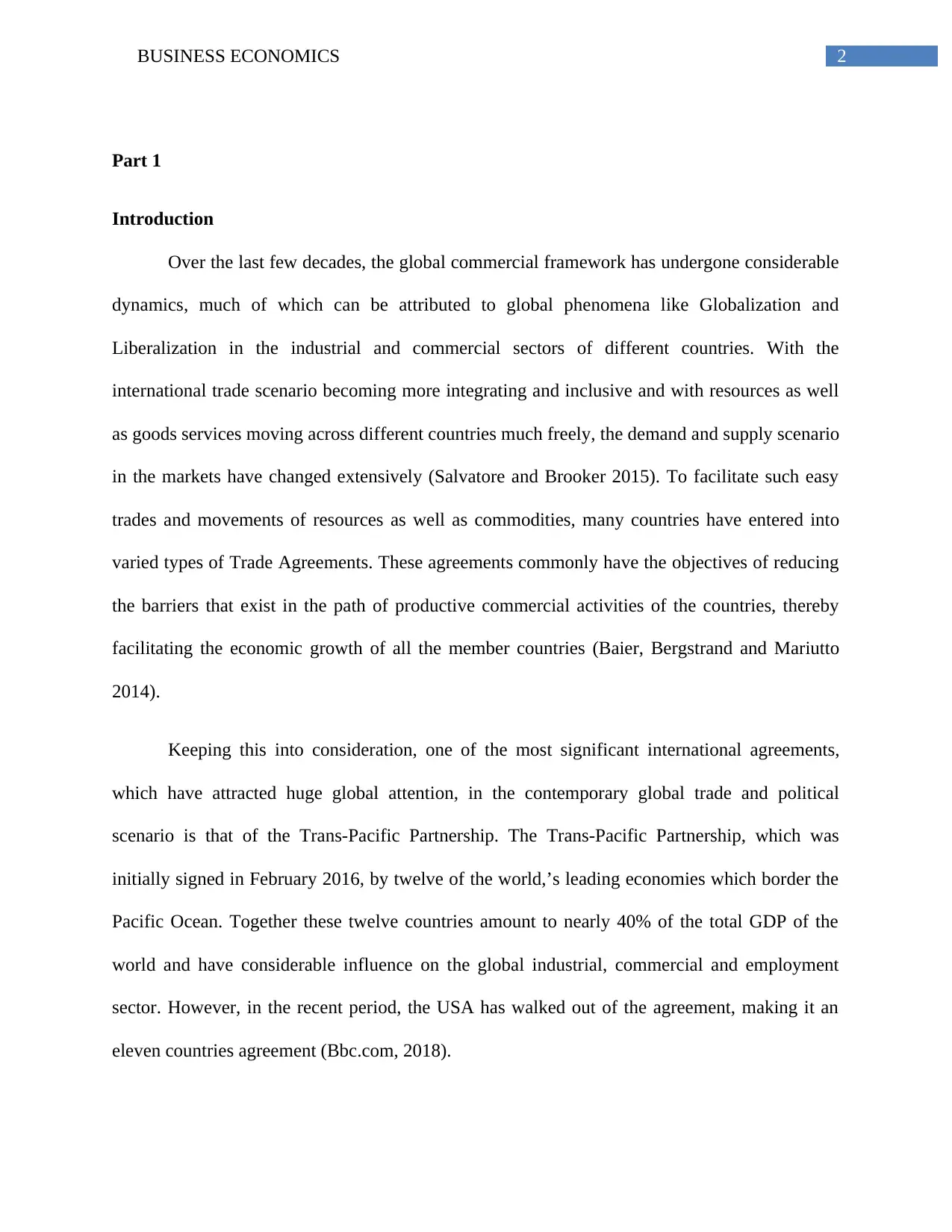
2BUSINESS ECONOMICS
Part 1
Introduction
Over the last few decades, the global commercial framework has undergone considerable
dynamics, much of which can be attributed to global phenomena like Globalization and
Liberalization in the industrial and commercial sectors of different countries. With the
international trade scenario becoming more integrating and inclusive and with resources as well
as goods services moving across different countries much freely, the demand and supply scenario
in the markets have changed extensively (Salvatore and Brooker 2015). To facilitate such easy
trades and movements of resources as well as commodities, many countries have entered into
varied types of Trade Agreements. These agreements commonly have the objectives of reducing
the barriers that exist in the path of productive commercial activities of the countries, thereby
facilitating the economic growth of all the member countries (Baier, Bergstrand and Mariutto
2014).
Keeping this into consideration, one of the most significant international agreements,
which have attracted huge global attention, in the contemporary global trade and political
scenario is that of the Trans-Pacific Partnership. The Trans-Pacific Partnership, which was
initially signed in February 2016, by twelve of the world,’s leading economies which border the
Pacific Ocean. Together these twelve countries amount to nearly 40% of the total GDP of the
world and have considerable influence on the global industrial, commercial and employment
sector. However, in the recent period, the USA has walked out of the agreement, making it an
eleven countries agreement (Bbc.com, 2018).
Part 1
Introduction
Over the last few decades, the global commercial framework has undergone considerable
dynamics, much of which can be attributed to global phenomena like Globalization and
Liberalization in the industrial and commercial sectors of different countries. With the
international trade scenario becoming more integrating and inclusive and with resources as well
as goods services moving across different countries much freely, the demand and supply scenario
in the markets have changed extensively (Salvatore and Brooker 2015). To facilitate such easy
trades and movements of resources as well as commodities, many countries have entered into
varied types of Trade Agreements. These agreements commonly have the objectives of reducing
the barriers that exist in the path of productive commercial activities of the countries, thereby
facilitating the economic growth of all the member countries (Baier, Bergstrand and Mariutto
2014).
Keeping this into consideration, one of the most significant international agreements,
which have attracted huge global attention, in the contemporary global trade and political
scenario is that of the Trans-Pacific Partnership. The Trans-Pacific Partnership, which was
initially signed in February 2016, by twelve of the world,’s leading economies which border the
Pacific Ocean. Together these twelve countries amount to nearly 40% of the total GDP of the
world and have considerable influence on the global industrial, commercial and employment
sector. However, in the recent period, the USA has walked out of the agreement, making it an
eleven countries agreement (Bbc.com, 2018).
⊘ This is a preview!⊘
Do you want full access?
Subscribe today to unlock all pages.

Trusted by 1+ million students worldwide
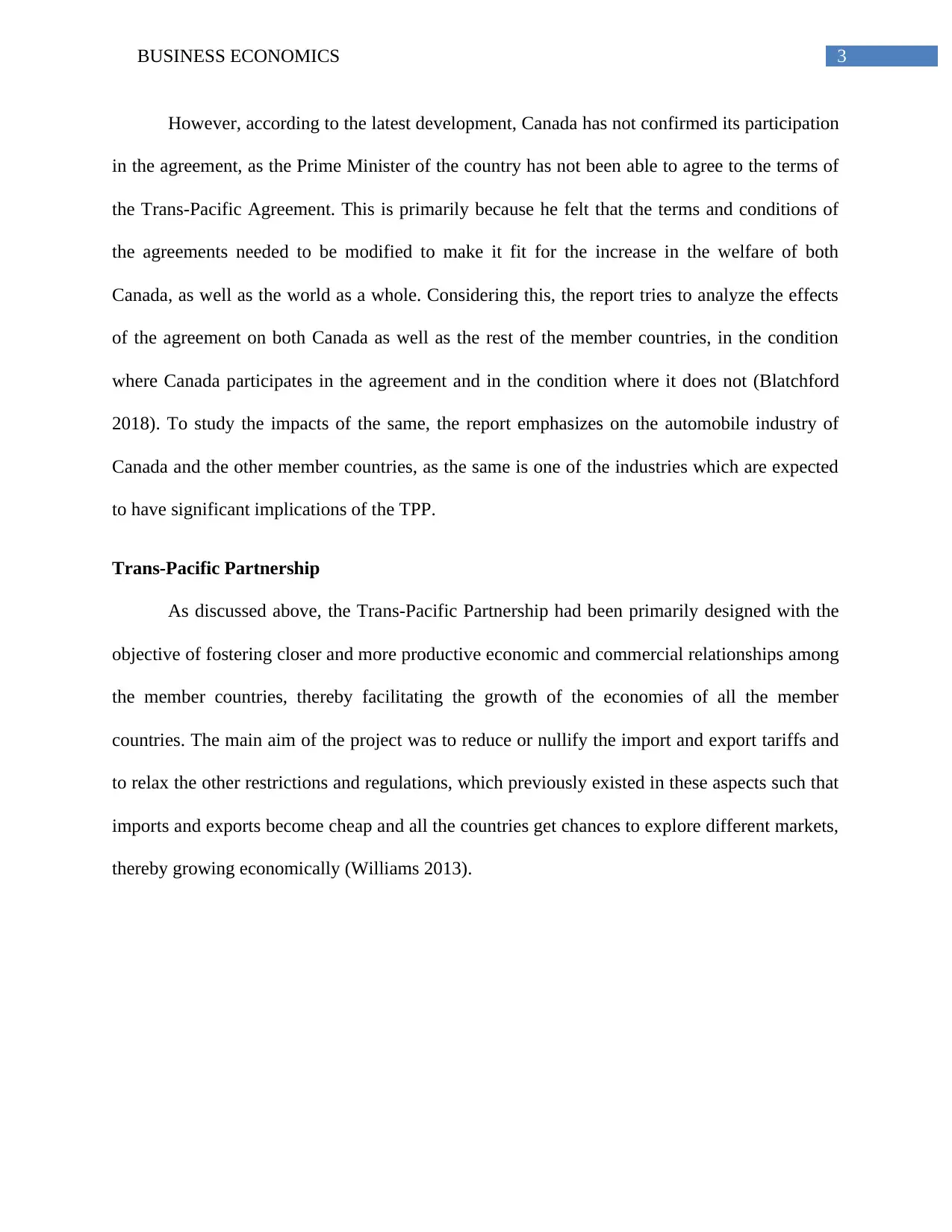
3BUSINESS ECONOMICS
However, according to the latest development, Canada has not confirmed its participation
in the agreement, as the Prime Minister of the country has not been able to agree to the terms of
the Trans-Pacific Agreement. This is primarily because he felt that the terms and conditions of
the agreements needed to be modified to make it fit for the increase in the welfare of both
Canada, as well as the world as a whole. Considering this, the report tries to analyze the effects
of the agreement on both Canada as well as the rest of the member countries, in the condition
where Canada participates in the agreement and in the condition where it does not (Blatchford
2018). To study the impacts of the same, the report emphasizes on the automobile industry of
Canada and the other member countries, as the same is one of the industries which are expected
to have significant implications of the TPP.
Trans-Pacific Partnership
As discussed above, the Trans-Pacific Partnership had been primarily designed with the
objective of fostering closer and more productive economic and commercial relationships among
the member countries, thereby facilitating the growth of the economies of all the member
countries. The main aim of the project was to reduce or nullify the import and export tariffs and
to relax the other restrictions and regulations, which previously existed in these aspects such that
imports and exports become cheap and all the countries get chances to explore different markets,
thereby growing economically (Williams 2013).
However, according to the latest development, Canada has not confirmed its participation
in the agreement, as the Prime Minister of the country has not been able to agree to the terms of
the Trans-Pacific Agreement. This is primarily because he felt that the terms and conditions of
the agreements needed to be modified to make it fit for the increase in the welfare of both
Canada, as well as the world as a whole. Considering this, the report tries to analyze the effects
of the agreement on both Canada as well as the rest of the member countries, in the condition
where Canada participates in the agreement and in the condition where it does not (Blatchford
2018). To study the impacts of the same, the report emphasizes on the automobile industry of
Canada and the other member countries, as the same is one of the industries which are expected
to have significant implications of the TPP.
Trans-Pacific Partnership
As discussed above, the Trans-Pacific Partnership had been primarily designed with the
objective of fostering closer and more productive economic and commercial relationships among
the member countries, thereby facilitating the growth of the economies of all the member
countries. The main aim of the project was to reduce or nullify the import and export tariffs and
to relax the other restrictions and regulations, which previously existed in these aspects such that
imports and exports become cheap and all the countries get chances to explore different markets,
thereby growing economically (Williams 2013).
Paraphrase This Document
Need a fresh take? Get an instant paraphrase of this document with our AI Paraphraser
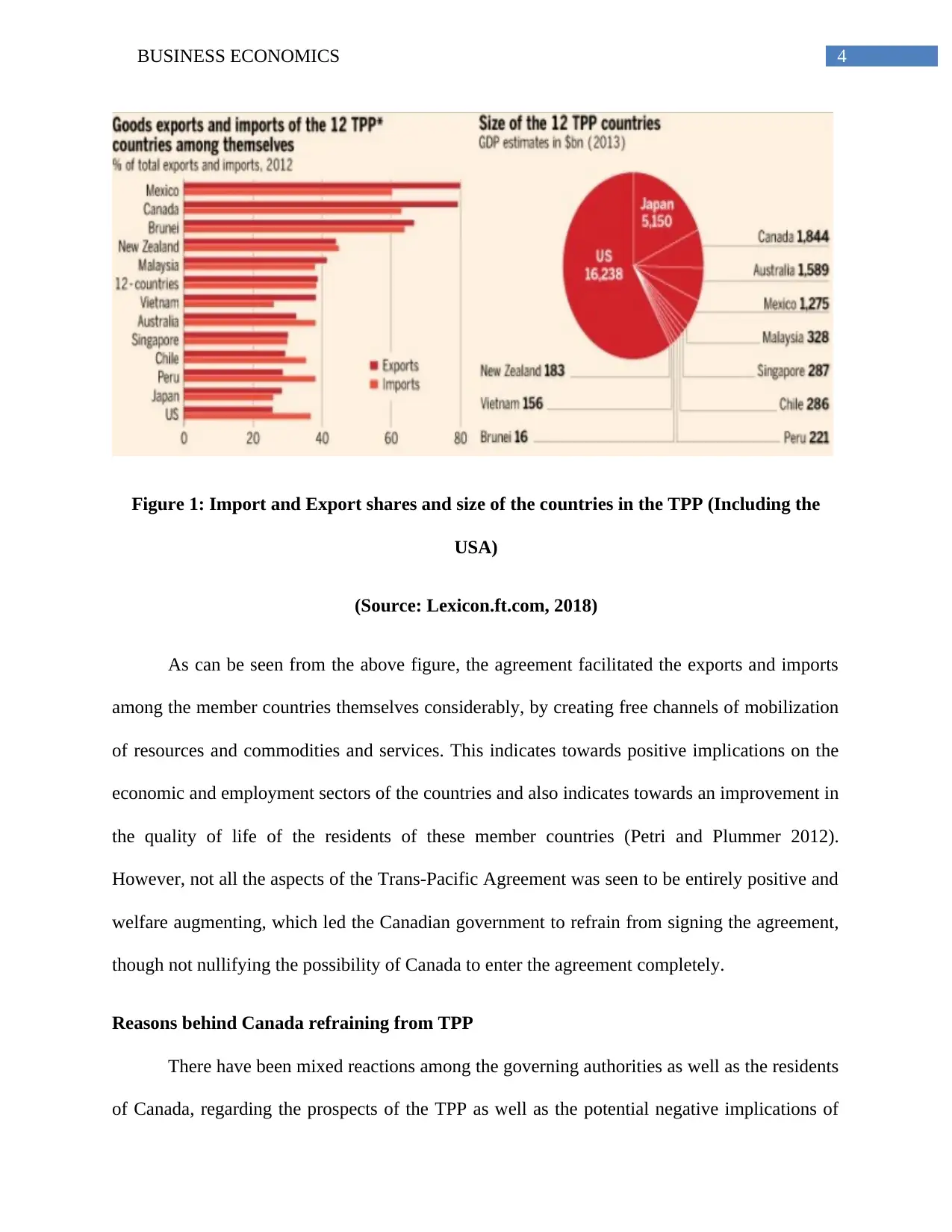
4BUSINESS ECONOMICS
Figure 1: Import and Export shares and size of the countries in the TPP (Including the
USA)
(Source: Lexicon.ft.com, 2018)
As can be seen from the above figure, the agreement facilitated the exports and imports
among the member countries themselves considerably, by creating free channels of mobilization
of resources and commodities and services. This indicates towards positive implications on the
economic and employment sectors of the countries and also indicates towards an improvement in
the quality of life of the residents of these member countries (Petri and Plummer 2012).
However, not all the aspects of the Trans-Pacific Agreement was seen to be entirely positive and
welfare augmenting, which led the Canadian government to refrain from signing the agreement,
though not nullifying the possibility of Canada to enter the agreement completely.
Reasons behind Canada refraining from TPP
There have been mixed reactions among the governing authorities as well as the residents
of Canada, regarding the prospects of the TPP as well as the potential negative implications of
Figure 1: Import and Export shares and size of the countries in the TPP (Including the
USA)
(Source: Lexicon.ft.com, 2018)
As can be seen from the above figure, the agreement facilitated the exports and imports
among the member countries themselves considerably, by creating free channels of mobilization
of resources and commodities and services. This indicates towards positive implications on the
economic and employment sectors of the countries and also indicates towards an improvement in
the quality of life of the residents of these member countries (Petri and Plummer 2012).
However, not all the aspects of the Trans-Pacific Agreement was seen to be entirely positive and
welfare augmenting, which led the Canadian government to refrain from signing the agreement,
though not nullifying the possibility of Canada to enter the agreement completely.
Reasons behind Canada refraining from TPP
There have been mixed reactions among the governing authorities as well as the residents
of Canada, regarding the prospects of the TPP as well as the potential negative implications of
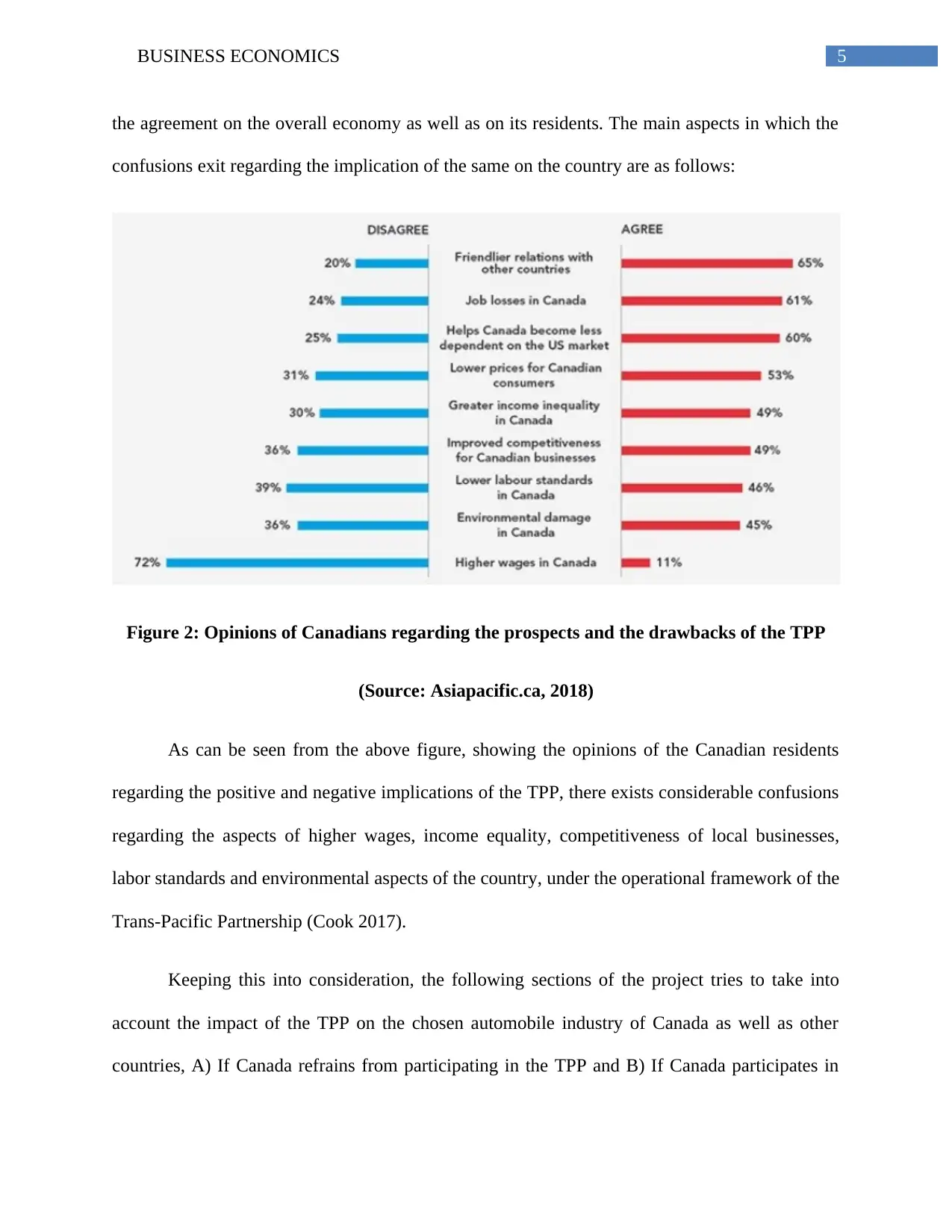
5BUSINESS ECONOMICS
the agreement on the overall economy as well as on its residents. The main aspects in which the
confusions exit regarding the implication of the same on the country are as follows:
Figure 2: Opinions of Canadians regarding the prospects and the drawbacks of the TPP
(Source: Asiapacific.ca, 2018)
As can be seen from the above figure, showing the opinions of the Canadian residents
regarding the positive and negative implications of the TPP, there exists considerable confusions
regarding the aspects of higher wages, income equality, competitiveness of local businesses,
labor standards and environmental aspects of the country, under the operational framework of the
Trans-Pacific Partnership (Cook 2017).
Keeping this into consideration, the following sections of the project tries to take into
account the impact of the TPP on the chosen automobile industry of Canada as well as other
countries, A) If Canada refrains from participating in the TPP and B) If Canada participates in
the agreement on the overall economy as well as on its residents. The main aspects in which the
confusions exit regarding the implication of the same on the country are as follows:
Figure 2: Opinions of Canadians regarding the prospects and the drawbacks of the TPP
(Source: Asiapacific.ca, 2018)
As can be seen from the above figure, showing the opinions of the Canadian residents
regarding the positive and negative implications of the TPP, there exists considerable confusions
regarding the aspects of higher wages, income equality, competitiveness of local businesses,
labor standards and environmental aspects of the country, under the operational framework of the
Trans-Pacific Partnership (Cook 2017).
Keeping this into consideration, the following sections of the project tries to take into
account the impact of the TPP on the chosen automobile industry of Canada as well as other
countries, A) If Canada refrains from participating in the TPP and B) If Canada participates in
⊘ This is a preview!⊘
Do you want full access?
Subscribe today to unlock all pages.

Trusted by 1+ million students worldwide
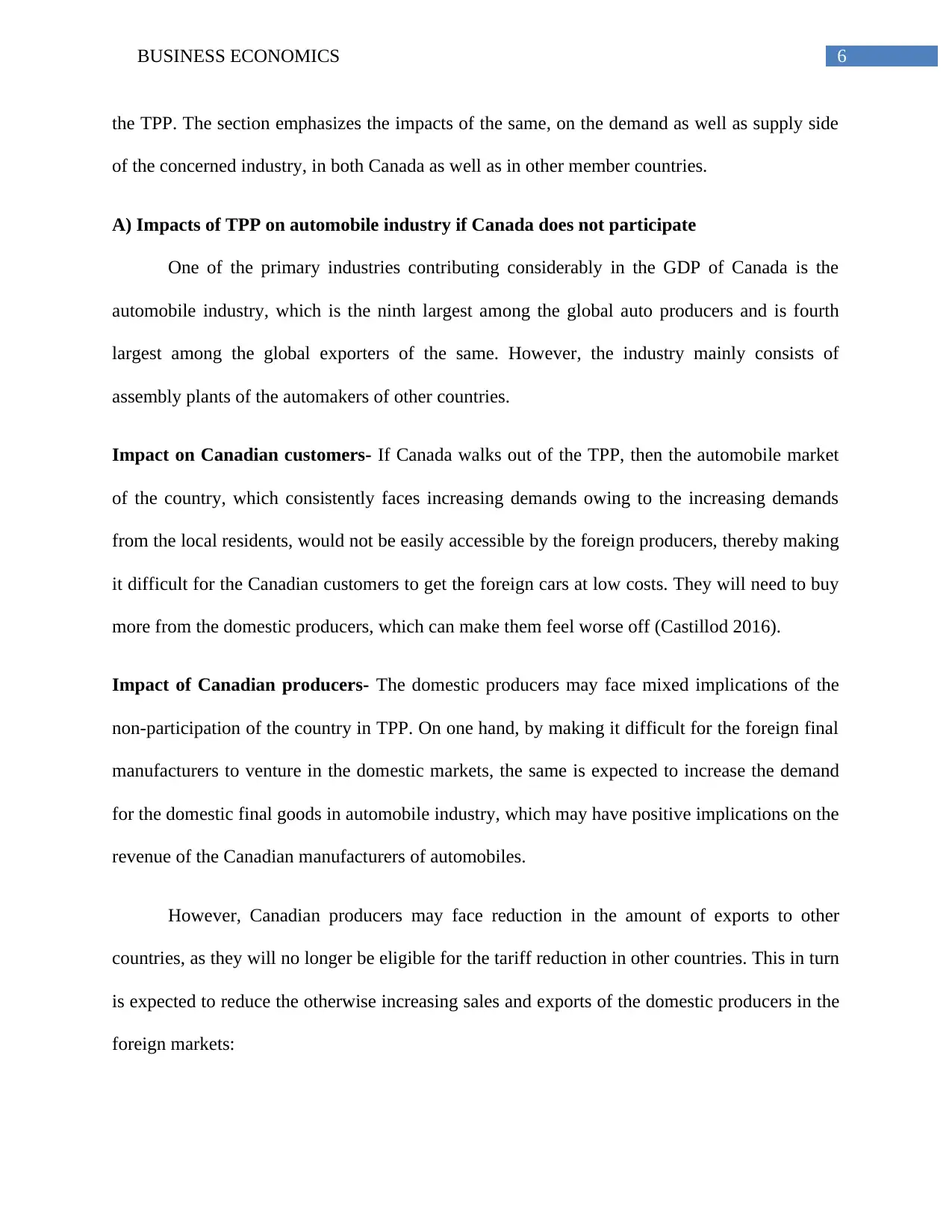
6BUSINESS ECONOMICS
the TPP. The section emphasizes the impacts of the same, on the demand as well as supply side
of the concerned industry, in both Canada as well as in other member countries.
A) Impacts of TPP on automobile industry if Canada does not participate
One of the primary industries contributing considerably in the GDP of Canada is the
automobile industry, which is the ninth largest among the global auto producers and is fourth
largest among the global exporters of the same. However, the industry mainly consists of
assembly plants of the automakers of other countries.
Impact on Canadian customers- If Canada walks out of the TPP, then the automobile market
of the country, which consistently faces increasing demands owing to the increasing demands
from the local residents, would not be easily accessible by the foreign producers, thereby making
it difficult for the Canadian customers to get the foreign cars at low costs. They will need to buy
more from the domestic producers, which can make them feel worse off (Castillod 2016).
Impact of Canadian producers- The domestic producers may face mixed implications of the
non-participation of the country in TPP. On one hand, by making it difficult for the foreign final
manufacturers to venture in the domestic markets, the same is expected to increase the demand
for the domestic final goods in automobile industry, which may have positive implications on the
revenue of the Canadian manufacturers of automobiles.
However, Canadian producers may face reduction in the amount of exports to other
countries, as they will no longer be eligible for the tariff reduction in other countries. This in turn
is expected to reduce the otherwise increasing sales and exports of the domestic producers in the
foreign markets:
the TPP. The section emphasizes the impacts of the same, on the demand as well as supply side
of the concerned industry, in both Canada as well as in other member countries.
A) Impacts of TPP on automobile industry if Canada does not participate
One of the primary industries contributing considerably in the GDP of Canada is the
automobile industry, which is the ninth largest among the global auto producers and is fourth
largest among the global exporters of the same. However, the industry mainly consists of
assembly plants of the automakers of other countries.
Impact on Canadian customers- If Canada walks out of the TPP, then the automobile market
of the country, which consistently faces increasing demands owing to the increasing demands
from the local residents, would not be easily accessible by the foreign producers, thereby making
it difficult for the Canadian customers to get the foreign cars at low costs. They will need to buy
more from the domestic producers, which can make them feel worse off (Castillod 2016).
Impact of Canadian producers- The domestic producers may face mixed implications of the
non-participation of the country in TPP. On one hand, by making it difficult for the foreign final
manufacturers to venture in the domestic markets, the same is expected to increase the demand
for the domestic final goods in automobile industry, which may have positive implications on the
revenue of the Canadian manufacturers of automobiles.
However, Canadian producers may face reduction in the amount of exports to other
countries, as they will no longer be eligible for the tariff reduction in other countries. This in turn
is expected to reduce the otherwise increasing sales and exports of the domestic producers in the
foreign markets:
Paraphrase This Document
Need a fresh take? Get an instant paraphrase of this document with our AI Paraphraser
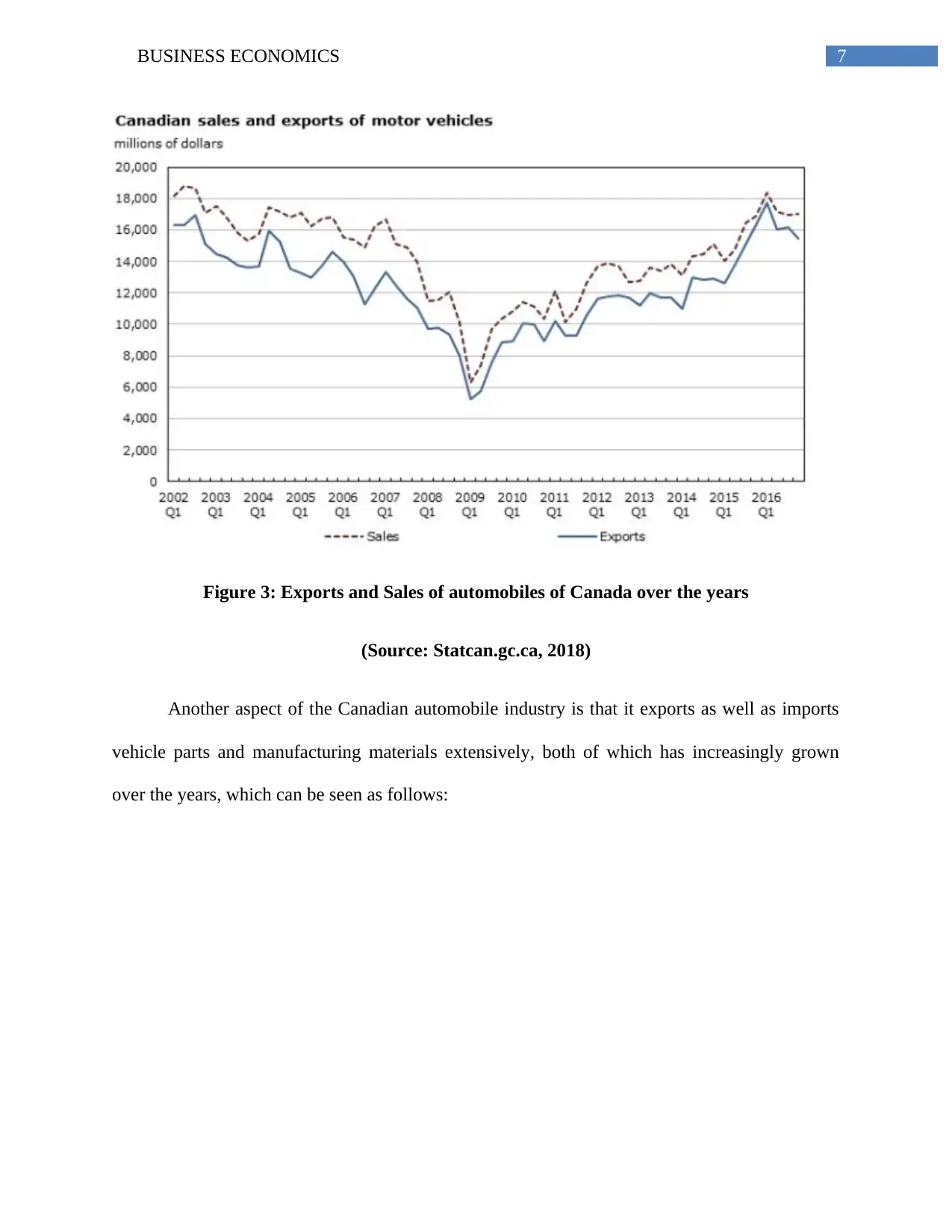
7BUSINESS ECONOMICS
Figure 3: Exports and Sales of automobiles of Canada over the years
(Source: Statcan.gc.ca, 2018)
Another aspect of the Canadian automobile industry is that it exports as well as imports
vehicle parts and manufacturing materials extensively, both of which has increasingly grown
over the years, which can be seen as follows:
Figure 3: Exports and Sales of automobiles of Canada over the years
(Source: Statcan.gc.ca, 2018)
Another aspect of the Canadian automobile industry is that it exports as well as imports
vehicle parts and manufacturing materials extensively, both of which has increasingly grown
over the years, which can be seen as follows:
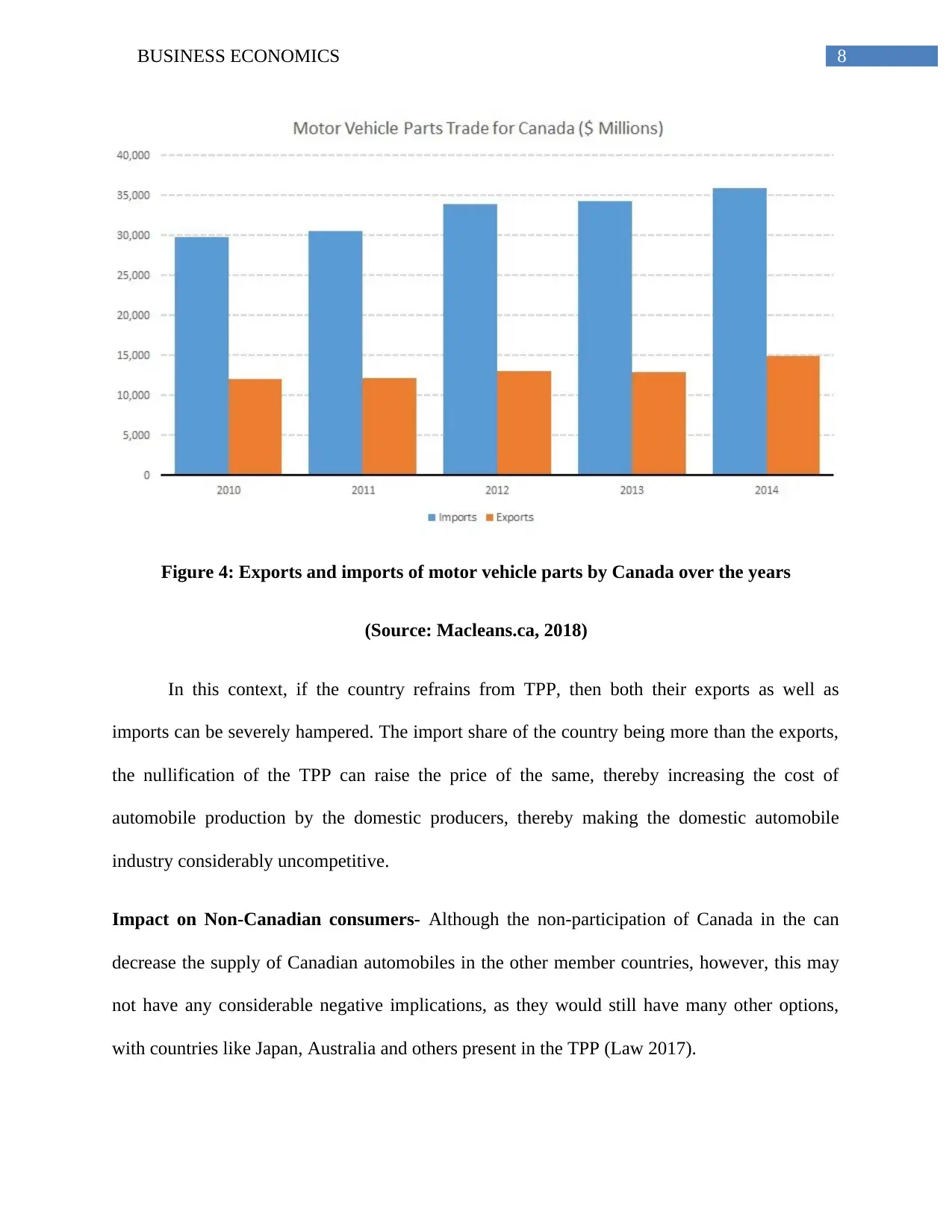
8BUSINESS ECONOMICS
Figure 4: Exports and imports of motor vehicle parts by Canada over the years
(Source: Macleans.ca, 2018)
In this context, if the country refrains from TPP, then both their exports as well as
imports can be severely hampered. The import share of the country being more than the exports,
the nullification of the TPP can raise the price of the same, thereby increasing the cost of
automobile production by the domestic producers, thereby making the domestic automobile
industry considerably uncompetitive.
Impact on Non-Canadian consumers- Although the non-participation of Canada in the can
decrease the supply of Canadian automobiles in the other member countries, however, this may
not have any considerable negative implications, as they would still have many other options,
with countries like Japan, Australia and others present in the TPP (Law 2017).
Figure 4: Exports and imports of motor vehicle parts by Canada over the years
(Source: Macleans.ca, 2018)
In this context, if the country refrains from TPP, then both their exports as well as
imports can be severely hampered. The import share of the country being more than the exports,
the nullification of the TPP can raise the price of the same, thereby increasing the cost of
automobile production by the domestic producers, thereby making the domestic automobile
industry considerably uncompetitive.
Impact on Non-Canadian consumers- Although the non-participation of Canada in the can
decrease the supply of Canadian automobiles in the other member countries, however, this may
not have any considerable negative implications, as they would still have many other options,
with countries like Japan, Australia and others present in the TPP (Law 2017).
⊘ This is a preview!⊘
Do you want full access?
Subscribe today to unlock all pages.

Trusted by 1+ million students worldwide
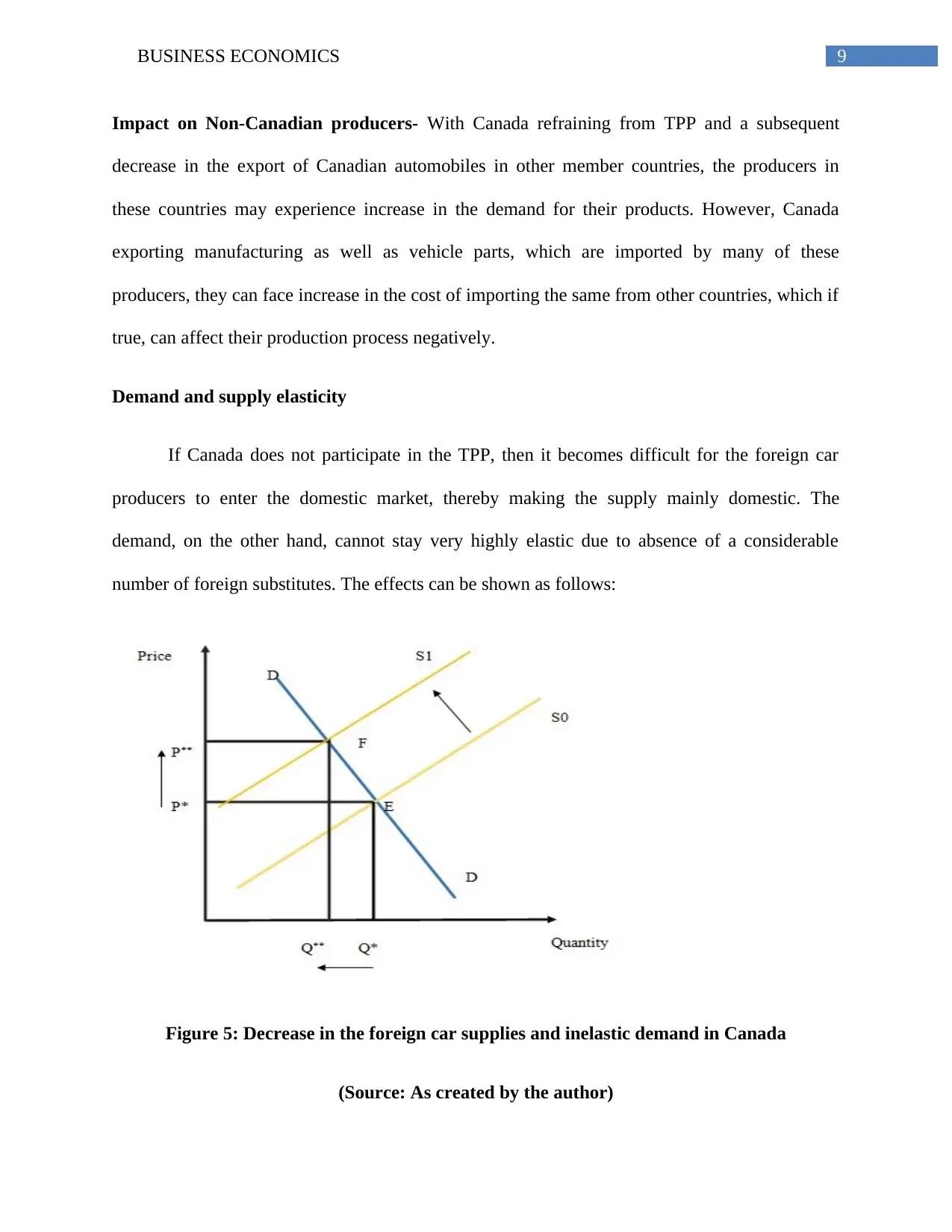
9BUSINESS ECONOMICS
Impact on Non-Canadian producers- With Canada refraining from TPP and a subsequent
decrease in the export of Canadian automobiles in other member countries, the producers in
these countries may experience increase in the demand for their products. However, Canada
exporting manufacturing as well as vehicle parts, which are imported by many of these
producers, they can face increase in the cost of importing the same from other countries, which if
true, can affect their production process negatively.
Demand and supply elasticity
If Canada does not participate in the TPP, then it becomes difficult for the foreign car
producers to enter the domestic market, thereby making the supply mainly domestic. The
demand, on the other hand, cannot stay very highly elastic due to absence of a considerable
number of foreign substitutes. The effects can be shown as follows:
Figure 5: Decrease in the foreign car supplies and inelastic demand in Canada
(Source: As created by the author)
Impact on Non-Canadian producers- With Canada refraining from TPP and a subsequent
decrease in the export of Canadian automobiles in other member countries, the producers in
these countries may experience increase in the demand for their products. However, Canada
exporting manufacturing as well as vehicle parts, which are imported by many of these
producers, they can face increase in the cost of importing the same from other countries, which if
true, can affect their production process negatively.
Demand and supply elasticity
If Canada does not participate in the TPP, then it becomes difficult for the foreign car
producers to enter the domestic market, thereby making the supply mainly domestic. The
demand, on the other hand, cannot stay very highly elastic due to absence of a considerable
number of foreign substitutes. The effects can be shown as follows:
Figure 5: Decrease in the foreign car supplies and inelastic demand in Canada
(Source: As created by the author)
Paraphrase This Document
Need a fresh take? Get an instant paraphrase of this document with our AI Paraphraser
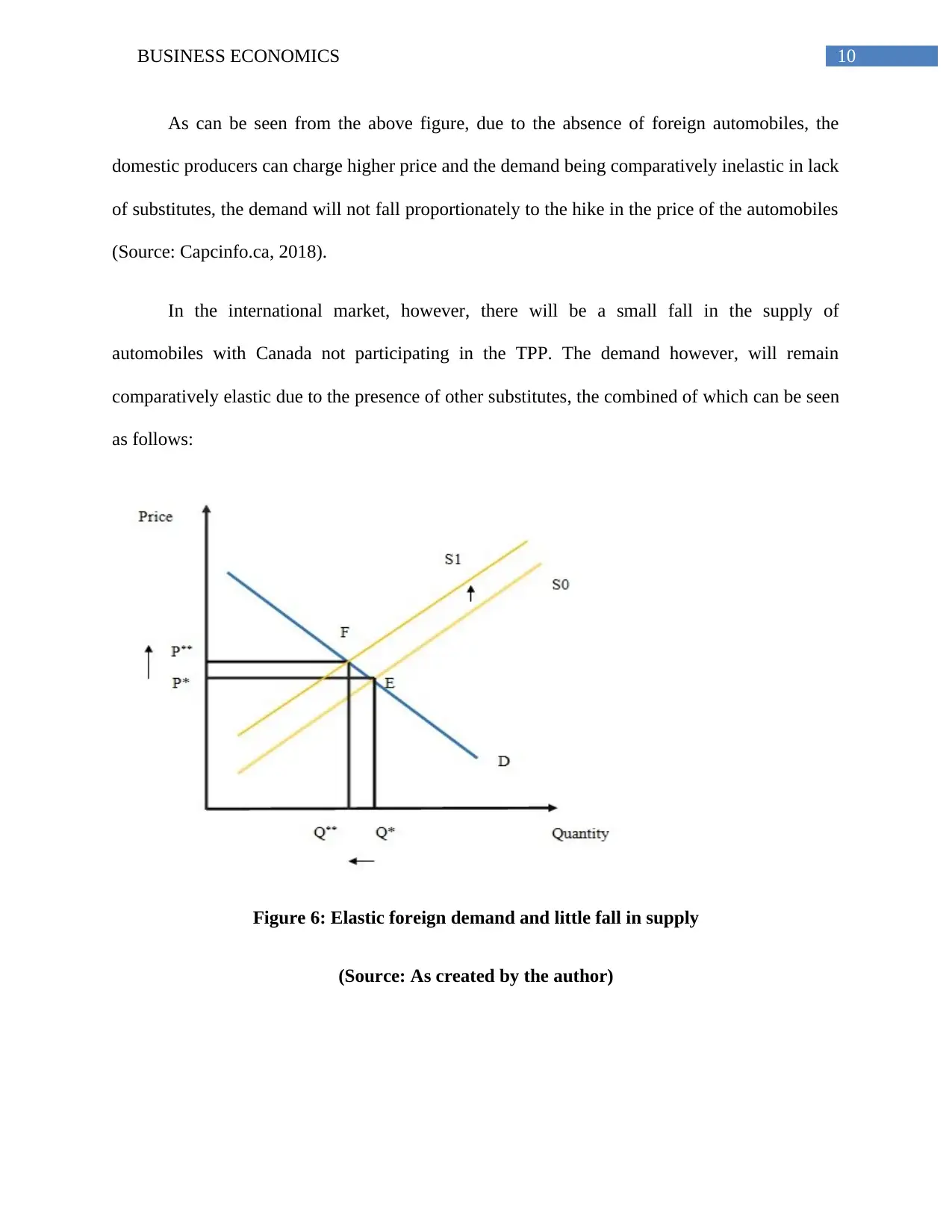
10BUSINESS ECONOMICS
As can be seen from the above figure, due to the absence of foreign automobiles, the
domestic producers can charge higher price and the demand being comparatively inelastic in lack
of substitutes, the demand will not fall proportionately to the hike in the price of the automobiles
(Source: Capcinfo.ca, 2018).
In the international market, however, there will be a small fall in the supply of
automobiles with Canada not participating in the TPP. The demand however, will remain
comparatively elastic due to the presence of other substitutes, the combined of which can be seen
as follows:
Figure 6: Elastic foreign demand and little fall in supply
(Source: As created by the author)
As can be seen from the above figure, due to the absence of foreign automobiles, the
domestic producers can charge higher price and the demand being comparatively inelastic in lack
of substitutes, the demand will not fall proportionately to the hike in the price of the automobiles
(Source: Capcinfo.ca, 2018).
In the international market, however, there will be a small fall in the supply of
automobiles with Canada not participating in the TPP. The demand however, will remain
comparatively elastic due to the presence of other substitutes, the combined of which can be seen
as follows:
Figure 6: Elastic foreign demand and little fall in supply
(Source: As created by the author)
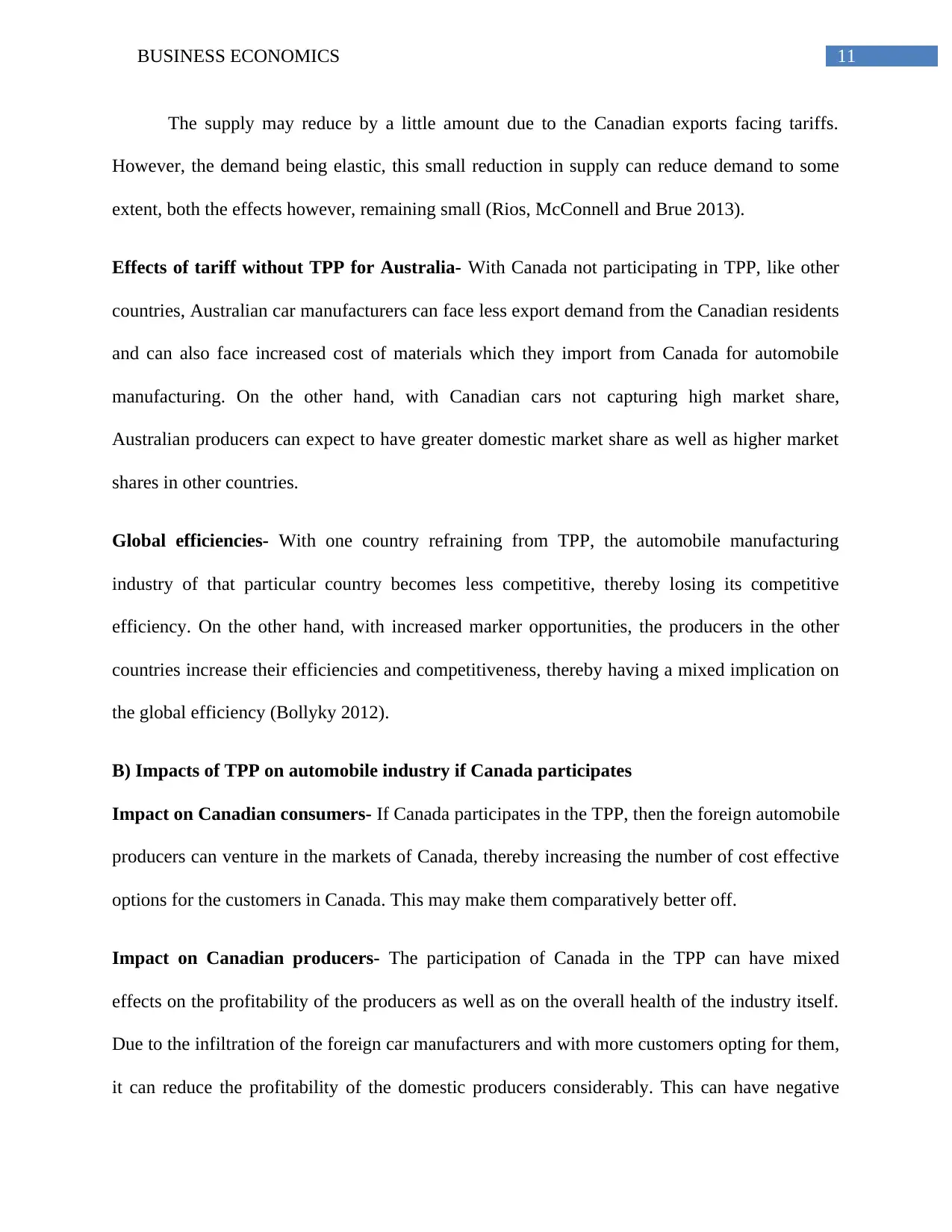
11BUSINESS ECONOMICS
The supply may reduce by a little amount due to the Canadian exports facing tariffs.
However, the demand being elastic, this small reduction in supply can reduce demand to some
extent, both the effects however, remaining small (Rios, McConnell and Brue 2013).
Effects of tariff without TPP for Australia- With Canada not participating in TPP, like other
countries, Australian car manufacturers can face less export demand from the Canadian residents
and can also face increased cost of materials which they import from Canada for automobile
manufacturing. On the other hand, with Canadian cars not capturing high market share,
Australian producers can expect to have greater domestic market share as well as higher market
shares in other countries.
Global efficiencies- With one country refraining from TPP, the automobile manufacturing
industry of that particular country becomes less competitive, thereby losing its competitive
efficiency. On the other hand, with increased marker opportunities, the producers in the other
countries increase their efficiencies and competitiveness, thereby having a mixed implication on
the global efficiency (Bollyky 2012).
B) Impacts of TPP on automobile industry if Canada participates
Impact on Canadian consumers- If Canada participates in the TPP, then the foreign automobile
producers can venture in the markets of Canada, thereby increasing the number of cost effective
options for the customers in Canada. This may make them comparatively better off.
Impact on Canadian producers- The participation of Canada in the TPP can have mixed
effects on the profitability of the producers as well as on the overall health of the industry itself.
Due to the infiltration of the foreign car manufacturers and with more customers opting for them,
it can reduce the profitability of the domestic producers considerably. This can have negative
The supply may reduce by a little amount due to the Canadian exports facing tariffs.
However, the demand being elastic, this small reduction in supply can reduce demand to some
extent, both the effects however, remaining small (Rios, McConnell and Brue 2013).
Effects of tariff without TPP for Australia- With Canada not participating in TPP, like other
countries, Australian car manufacturers can face less export demand from the Canadian residents
and can also face increased cost of materials which they import from Canada for automobile
manufacturing. On the other hand, with Canadian cars not capturing high market share,
Australian producers can expect to have greater domestic market share as well as higher market
shares in other countries.
Global efficiencies- With one country refraining from TPP, the automobile manufacturing
industry of that particular country becomes less competitive, thereby losing its competitive
efficiency. On the other hand, with increased marker opportunities, the producers in the other
countries increase their efficiencies and competitiveness, thereby having a mixed implication on
the global efficiency (Bollyky 2012).
B) Impacts of TPP on automobile industry if Canada participates
Impact on Canadian consumers- If Canada participates in the TPP, then the foreign automobile
producers can venture in the markets of Canada, thereby increasing the number of cost effective
options for the customers in Canada. This may make them comparatively better off.
Impact on Canadian producers- The participation of Canada in the TPP can have mixed
effects on the profitability of the producers as well as on the overall health of the industry itself.
Due to the infiltration of the foreign car manufacturers and with more customers opting for them,
it can reduce the profitability of the domestic producers considerably. This can have negative
⊘ This is a preview!⊘
Do you want full access?
Subscribe today to unlock all pages.

Trusted by 1+ million students worldwide
1 out of 25
Related Documents
Your All-in-One AI-Powered Toolkit for Academic Success.
+13062052269
info@desklib.com
Available 24*7 on WhatsApp / Email
![[object Object]](/_next/static/media/star-bottom.7253800d.svg)
Unlock your academic potential
Copyright © 2020–2025 A2Z Services. All Rights Reserved. Developed and managed by ZUCOL.





